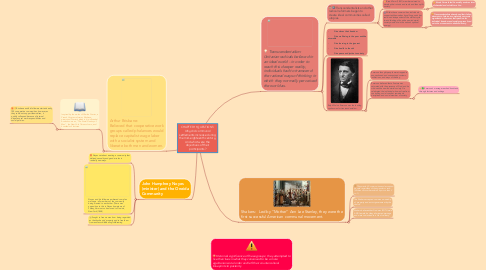
1. Arthur Brisbane: Believed that cooperative work groups called phalanxes would replace capitalist wage labor with a socialist system and liberate both men and women.
1.1. Inspired by the works of Charles Fourier, a French Utopian reformer, Brisbane promoted Fourier's ideas in his influential books known as, "The Social Destiny of Man", the New York Times column, and hundreds of lectures.
1.1.1. Brisbane and his followers started nearly 100 cooperative communities, however, as they could not support themselves, it quickly collapsed because of internal disputes over work responsibilities and social policies.
2. John Humphrey Noyes (minister) and the Oneida Community
2.1. Noyes set about creating a community that defined sexuality and gender roles in radically new ways.
2.2. Noyes and his followers embraced complex marriage - all members of the community being married to each other. (There was opposition to this in Noyes hometown of Putney, Vermont so he moved to Oneida, New York (1848)
2.3. Sought to free women from being regarded as their husbands’ property and to free them from endless childbearing/childrearing
3. Transcendentalism: Unitarian radicals believed in an ideal world - in order to reach this deeper reality, individuals had to transcend the rational ways of thinking in which they normally perceived the world as.
3.1. Transcendentalists and other radical reformers began to create ideal communities called utopias.
3.1.1. Brook Farm (1841) members aimed to develop their minds and souls and then uplift society.
3.1.1.1. Brook Farms failed financially and was later disbanded and sold after a fire.
3.1.2. Within these communities, individuals supported themselves by selling goods but remained independent of the market cycle. (weird thinking of how the new industrial society would drain the nation’s spiritual energy)
3.1.2.1. Transcendentalists abandoned their failed attempts to fashion a completely new social organization; however, their passion for individual freedom and social progress lived on in the movement to abolish slavery.
3.2. - Give slaves their freedom - Give well-being to the poor and the miserable - Give learning to the ignorant - Give health to the sick - Give peace and justice to society
3.3. Ralph Waldo Emerson was the leading spokesman for transcendentalism.
3.3.1. Emerson thought people were trapped in unquestioned and unexamined customs, institutions, and ways of thinking
3.3.2. Emerson believed that all nature was saturated with the presence of God, and he criticized the new industrial society. He celebrated the individual who was free from controlling social cues but remained a disciplined and social member of society
3.3.2.1. Emerson's message reached hundreds through lectures and writings
